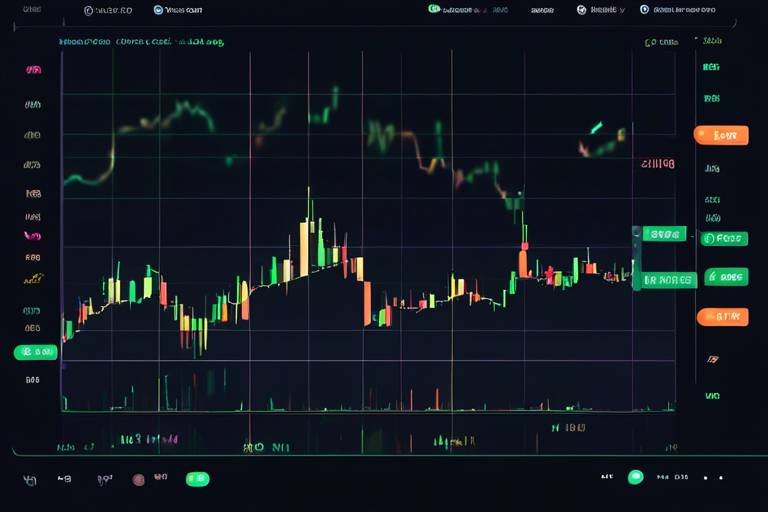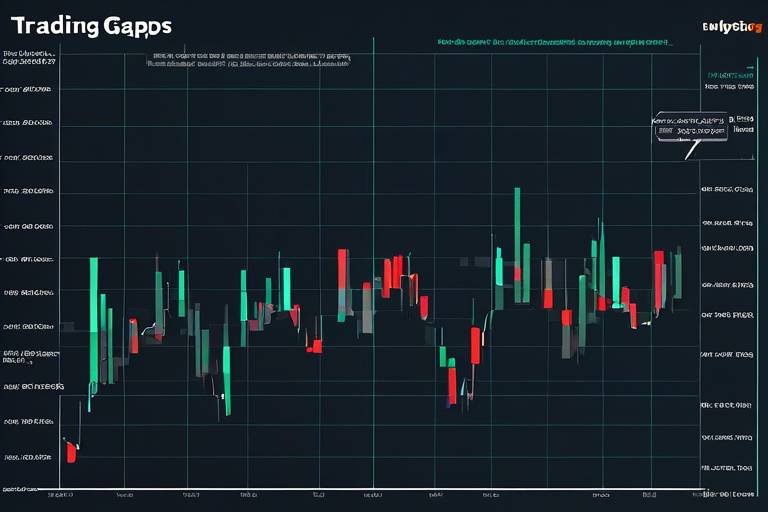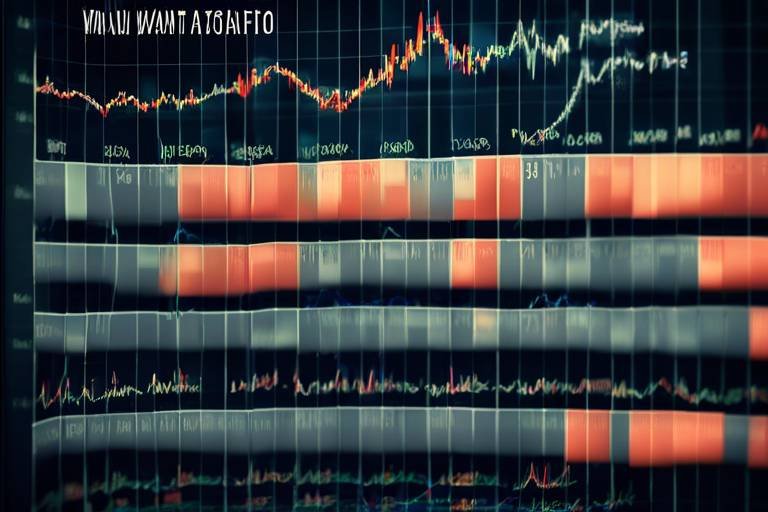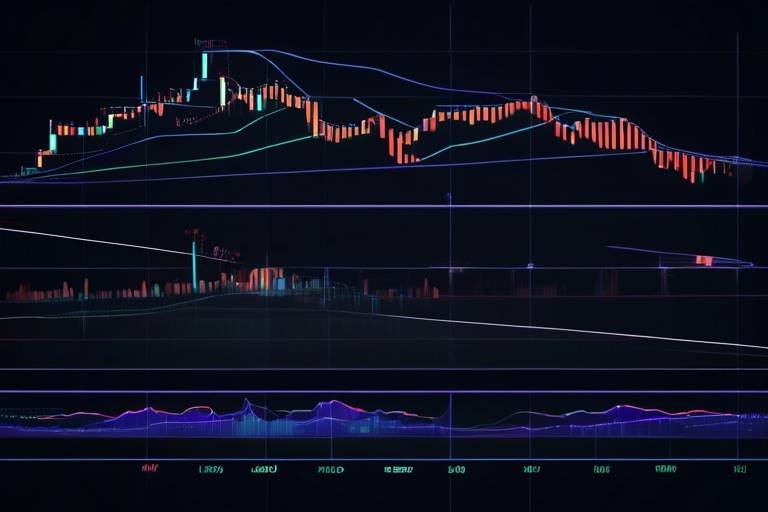How to Spot Reversal Patterns in Cryptocurrency Charts
In the fast-paced world of cryptocurrency trading, spotting reversal patterns is like having a secret weapon in your trading arsenal. These patterns are crucial indicators that can signal a significant shift in market trends, allowing traders to make informed decisions. Imagine you’re navigating a stormy sea; knowing when the tide is about to change can mean the difference between smooth sailing and capsizing. In this article, we will delve into the intricacies of reversal patterns, their significance, and how to identify and trade them effectively.
Reversal patterns are formations that suggest a change in the direction of an asset's price trend. They can occur at the end of a bullish or bearish trend and are essential for traders looking to minimize risks and maximize profits. Recognizing these patterns can be likened to reading the signs of an approaching storm; being aware of them can help you prepare and act accordingly. For instance, if you notice a head and shoulders pattern forming after a bullish run, it may be time to consider selling or shorting your position. On the flip side, spotting an inverse head and shoulders after a downtrend might signal a prime buying opportunity.
There are several prevalent reversal patterns that every cryptocurrency trader should familiarize themselves with. Each pattern has unique characteristics that can help traders make educated decisions. Here are a few key patterns to watch out for:
- Head and Shoulders: A classic pattern that indicates a trend reversal, typically occurring after an uptrend.
- Inverse Head and Shoulders: This pattern suggests a bullish reversal, often emerging after a downtrend.
- Double Tops and Bottoms: These patterns signify a shift in market momentum and can be powerful indicators of trend changes.
- Triangles: Ascending and descending triangles can also hint at potential reversals, depending on their formation.
The head and shoulders pattern is one of the most recognized reversal patterns in technical analysis. It typically forms after a strong uptrend and consists of three peaks: the left shoulder, the head, and the right shoulder. The left and right shoulders are roughly equal in height, while the head is the highest peak. Understanding this formation can help traders anticipate market shifts effectively. When the price breaks below the neckline, which is drawn by connecting the lows of the two shoulders, it often confirms the reversal.
Conversely, the inverse head and shoulders pattern suggests a bullish reversal and usually occurs after a downtrend. It mirrors the head and shoulders pattern but in reverse. Traders can spot this pattern by identifying three troughs, where the middle trough (head) is the lowest. Recognizing this pattern can signal potential buying opportunities, especially when the price breaks above the neckline, indicating a shift in market sentiment.
To effectively identify the head and shoulders pattern, traders should look for the following key indicators:
- Three distinct peaks, with the middle one (the head) being the highest.
- Declining volume as the pattern forms, indicating weakening momentum.
- A clear neckline that connects the lows of the two shoulders.
By paying attention to these details, traders can better anticipate potential market reversals.
Double tops and bottoms are significant reversal patterns that indicate a shift in market momentum. A double top forms after an uptrend and consists of two peaks at roughly the same price level, followed by a drop below the support level. On the other hand, a double bottom occurs after a downtrend, displaying two troughs at similar levels followed by a price increase. Recognizing these patterns can be instrumental in making profitable trades, as they often signal strong reversals in market direction.
Volume is a critical component in validating reversal patterns. It provides insight into the strength of a price movement and can confirm whether a reversal is likely to hold. For instance, if a head and shoulders pattern forms with increasing volume on the right shoulder, it adds credibility to the potential reversal. Conversely, if the volume is low, it may indicate a lack of conviction in the pattern.
Understanding volume spikes during pattern formations can enhance trading decisions. When traders see a significant increase in volume accompanying a breakout from a reversal pattern, it often suggests strong interest and can validate the reversal. This volume analysis can be the difference between a successful trade and a missed opportunity.
In addition to volume analysis, various technical indicators can help confirm reversal patterns. Indicators such as the Relative Strength Index (RSI) and Moving Average Convergence Divergence (MACD) can provide additional insights into market momentum. For example, if the RSI indicates an overbought condition during a head and shoulders formation, it can reinforce the likelihood of a reversal. Integrating these indicators into trading strategies can significantly improve decision-making.
Implementing effective trading strategies based on reversal patterns can enhance profitability. Here are some actionable tips for traders looking to capitalize on these patterns in the cryptocurrency market:
- Always wait for confirmation before entering a trade. Look for volume spikes and indicator signals.
- Set stop-loss orders to manage risk effectively.
- Consider using a combination of multiple reversal patterns for a more robust trading strategy.
By applying these strategies, traders can navigate the often volatile cryptocurrency market with greater confidence and success.
Q: What are reversal patterns?
A: Reversal patterns are formations on price charts that indicate a potential change in the direction of the market trend, such as from bullish to bearish or vice versa.
Q: How can I identify a head and shoulders pattern?
A: Look for three peaks, with the middle peak being the highest, and a neckline connecting the lows of the two shoulders. Confirm with volume trends and other indicators.
Q: Why is volume important in reversal patterns?
A: Volume helps validate the strength of a reversal pattern. Higher volume during a breakout often indicates strong interest and increases the likelihood of a trend reversal holding.
Q: Can I trade based solely on reversal patterns?
A: While reversal patterns are valuable tools, it’s advisable to use them in conjunction with other indicators and analysis methods to make more informed trading decisions.

Understanding Reversal Patterns
When it comes to trading in the cryptocurrency market, understanding reversal patterns is absolutely crucial. These patterns are like the warning signs on a road, indicating that a change in direction is imminent. In simpler terms, a reversal pattern suggests that the current trend—whether bullish or bearish—is about to take a detour. This knowledge can be a game-changer for traders, helping them to not only minimize risks but also to maximize potential profits.
Now, why should you care about these patterns? Well, think of the cryptocurrency market as a rollercoaster ride. It’s thrilling, unpredictable, and can leave you feeling exhilarated or nauseated—sometimes both! Recognizing reversal patterns is akin to knowing when the ride is about to take a steep drop or climb. It allows you to brace yourself for the changes and make informed decisions rather than being caught off guard.
Reversal patterns can be categorized into two main types: bullish and bearish. Bullish reversal patterns indicate that the price is likely to rise after a downtrend, while bearish reversal patterns suggest a price drop following an uptrend. By understanding these patterns, traders can position themselves to either enter or exit trades at the right moments.
For instance, consider the head and shoulders pattern, which typically forms after a significant upward movement. This pattern consists of three peaks: the first and third peaks (the shoulders) are lower than the middle peak (the head). When traders spot this formation, it often signals that the market is about to shift from bullish to bearish. Conversely, the inverse head and shoulders pattern, which emerges after a downward trend, can signal a bullish reversal, indicating potential buying opportunities.
Moreover, it’s essential to recognize that reversal patterns don’t operate in isolation. They are often accompanied by changes in volume, which can act as a confirmation signal. For instance, if you spot a head and shoulders pattern forming, but the volume is decreasing, it might be wise to proceed with caution. Volume serves as a valuable tool in validating the strength of a reversal pattern. A significant increase in volume during the formation of these patterns often indicates that the market participants are on board with the potential trend change.
In summary, understanding reversal patterns is not just about recognizing shapes on a chart; it’s about interpreting the market’s sentiment and making informed trading decisions. By honing your skills in identifying these patterns, you can become a more effective trader in the ever-changing world of cryptocurrencies. So, keep your eyes peeled for those telltale signs, and you might just find yourself riding the waves of the market with greater confidence.

Common Types of Reversal Patterns
When it comes to trading cryptocurrencies, understanding reversal patterns is crucial for predicting potential shifts in market trends. These patterns are like the signs on a road that guide you through the twists and turns of the financial landscape. Recognizing them can be the difference between a profitable trade and a costly mistake. Let's dive into some of the most prevalent reversal patterns that traders should be aware of.
One of the most recognized patterns is the Head and Shoulders formation. This pattern typically appears after an uptrend and signifies a potential reversal to the downside. Imagine a person’s head and shoulders; the left shoulder represents a peak, the head is the highest peak, and the right shoulder mirrors the left. This formation is not just a random occurrence; it’s a visual representation of market psychology. Traders often see this pattern as a signal to sell, anticipating a drop in prices.
On the flip side, we have the Inverse Head and Shoulders pattern, which suggests a bullish reversal after a downtrend. This pattern is like a phoenix rising from the ashes, indicating that the market is ready to bounce back. Identifying this pattern can be a golden opportunity for traders looking to enter the market at a lower price before a potential surge. The inverse head and shoulders consist of three troughs, with the middle trough being the lowest, creating a mirror image of its counterpart.
Another significant pattern to consider is the Double Top and Double Bottom. The double top occurs after an uptrend and indicates a potential reversal to the downside. It’s characterized by two peaks at roughly the same price level, suggesting that the market is struggling to break through that resistance. Conversely, the double bottom appears after a downtrend and signals a potential bullish reversal. It consists of two troughs at similar price levels, indicating that buyers are stepping in to support the price. Understanding these patterns can help traders spot when the market is losing momentum and prepare for a potential trend change.
In addition to these well-known patterns, traders should also be aware of Triangles. Triangles can be ascending, descending, or symmetrical, and they often indicate a period of consolidation before a breakout. An ascending triangle typically signals bullish sentiment, while a descending triangle suggests bearish sentiment. Symmetrical triangles can break either way, making them a bit more unpredictable. Recognizing these formations can provide valuable insights into potential price movements.
To sum it up, here’s a quick recap of the common types of reversal patterns:
| Pattern | Description | Market Implication |
|---|---|---|
| Head and Shoulders | Signals a bearish reversal after an uptrend | Potential sell signal |
| Inverse Head and Shoulders | Indicates a bullish reversal after a downtrend | Potential buy signal |
| Double Top | Suggests a bearish reversal after an uptrend | Potential sell signal |
| Double Bottom | Indicates a bullish reversal after a downtrend | Potential buy signal |
| Triangles | Indicates consolidation and potential breakout | Watch for breakout direction |
Recognizing these reversal patterns can significantly enhance your trading strategy. By understanding the psychology behind each formation, you can make more informed decisions and position yourself for better outcomes in the ever-changing world of cryptocurrency trading.

Head and Shoulders
The pattern is one of the most recognized reversal patterns in the world of technical analysis, particularly in the volatile cryptocurrency market. This pattern typically emerges after a significant uptrend and is characterized by three peaks: a higher peak (the head) flanked by two lower peaks (the shoulders). Understanding this formation can be a game changer for traders looking to anticipate market shifts. But why is this pattern so important? Well, it signifies a potential trend reversal, which can lead to substantial profit opportunities if identified correctly.
When traders spot a head and shoulders pattern, they should be on high alert. It suggests that the prevailing upward momentum is losing steam, and a downward trend may be on the horizon. The psychology behind this pattern is fascinating: after a strong rally, buyers start to lose confidence, leading to a sell-off. This shift can often be attributed to various market factors, such as negative news or a change in investor sentiment. But how do you actually identify this pattern on a chart?
To spot a head and shoulders pattern effectively, traders should look for the following key characteristics:
- First Shoulder: The price rises to a peak and then declines.
- Head: The price rises again to a higher peak and then declines once more.
- Second Shoulder: The price rises for a third time but does not exceed the height of the head, before declining again.
Once this pattern is confirmed, the next step is to determine the neckline. This is a crucial support level that connects the lows of the declines after the first shoulder and the head. A break below this neckline is often seen as a confirmation of the reversal, signaling traders to consider short positions. But remember, it's not just about spotting the pattern; volume also plays a critical role in validating its strength.
In summary, the head and shoulders pattern is a powerful indicator of potential market reversals. By recognizing it early, traders can position themselves advantageously to capitalize on the ensuing price movements. However, like any trading strategy, it should be used in conjunction with other tools and indicators for the best results. So, keep your eyes peeled for those peaks and valleys, and you might just find yourself ahead of the curve!

Inverse Head and Shoulders
The pattern is a powerful signal for traders looking to identify potential bullish reversals in the cryptocurrency market. This pattern typically forms after a downtrend, indicating that the asset might be poised for a price increase. Imagine a mountain range where the first peak is a shoulder, the second, higher peak is the head, and the third peak, which is again lower, forms the second shoulder. This visual representation helps traders easily recognize the setup and anticipate a shift in market sentiment.
To spot an inverse head and shoulders pattern, traders should look for three distinct troughs. The first trough represents the left shoulder, followed by a deeper trough that forms the head, and finally, the right shoulder, which should be similar in depth to the left shoulder. This formation suggests that buyers are gaining strength, as the price fails to drop below the level of the previous lows. The critical part of this pattern is the neckline, which is drawn across the peaks of the shoulders. A breakout above this neckline often confirms the bullish reversal, signaling traders to consider entering long positions.
Understanding the significance of volume during the formation of this pattern is crucial. Ideally, volume should increase as the price approaches the neckline, indicating strong buying interest. If the breakout occurs with a surge in volume, it adds further credibility to the reversal signal. Conversely, a breakout on low volume might raise red flags, suggesting a lack of conviction in the move.
Incorporating other technical indicators can also enhance the reliability of the inverse head and shoulders pattern. For instance, the Relative Strength Index (RSI) can help traders gauge whether the asset is oversold, providing additional confirmation of a potential reversal. Similarly, the Moving Average Convergence Divergence (MACD) can indicate bullish momentum, making it a valuable tool in conjunction with the inverse head and shoulders pattern.
In summary, the inverse head and shoulders pattern is a compelling indicator for traders seeking to capitalize on bullish reversals. By recognizing this formation, understanding its components, and analyzing volume trends alongside technical indicators, traders can make more informed decisions in the ever-volatile cryptocurrency market.
- What is the inverse head and shoulders pattern?
The inverse head and shoulders pattern is a technical analysis formation that indicates a potential bullish reversal after a downtrend, characterized by three troughs: two shoulders and a head. - How can I identify an inverse head and shoulders pattern?
Look for three troughs where the first and third are of similar height (shoulders) and the second is lower (head). The pattern is confirmed when the price breaks above the neckline. - What role does volume play in this pattern?
Volume should ideally increase as the price approaches the neckline. A breakout on high volume confirms the strength of the reversal, while low volume may suggest a lack of conviction. - Can I use other indicators with the inverse head and shoulders pattern?
Yes, using indicators like RSI and MACD can provide additional confirmation of the bullish reversal and help in making more informed trading decisions.

Identifying the Pattern
Identifying the head and shoulders pattern in cryptocurrency charts is crucial for traders looking to capitalize on potential market reversals. This pattern consists of three distinct peaks: the left shoulder, the head, and the right shoulder. The left shoulder is formed when the price rises to a peak and then declines, followed by a rise to a higher peak, which is the head. Finally, the price declines again before rising to a peak that is lower than the head, completing the right shoulder. Recognizing these peaks is essential, as they signal the potential for a trend reversal.
To effectively identify this pattern, traders should keep an eye on the following key indicators:
- Price Action: Look for the distinct three-peak formation that defines the head and shoulders.
- Neckline: Draw a line connecting the lowest points of the two troughs. This neckline serves as a critical support level.
- Volume Trends: Pay attention to volume trends accompanying the peaks. Ideally, volume should decrease as the peaks form, indicating weakening buying pressure.
One effective way to visualize this pattern is by using a charting tool. Below is a simple representation of the head and shoulders pattern:
| Peak Type | Price Action |
|---|---|
| Left Shoulder | Price rises, then declines. |
| Head | Price rises to a higher peak, then declines. |
| Right Shoulder | Price rises to a lower peak, then declines. |
Once the right shoulder is formed and the price breaks below the neckline, it confirms the pattern and signals a potential trend reversal. This is where traders can prepare to enter a short position or exit their long positions, depending on their strategy. It's essential to combine this pattern with other indicators for validation, enhancing the reliability of the trade setup.
In summary, identifying the head and shoulders pattern involves recognizing the three peaks, drawing the neckline, and observing volume trends. By mastering this technique, traders can position themselves advantageously in the ever-changing cryptocurrency market.
Q: How reliable are reversal patterns in cryptocurrency trading?
A: While reversal patterns can provide valuable insights, they are not foolproof. It's essential to use them in conjunction with other indicators and market analysis for better accuracy.
Q: Can reversal patterns occur in any time frame?
A: Yes, reversal patterns can appear in various time frames, from minutes to daily charts. However, the significance of the pattern often increases with longer time frames.
Q: What should I do if the pattern fails?
A: If a reversal pattern fails, it's crucial to have a risk management strategy in place. This may involve setting stop-loss orders to minimize potential losses.

Double Tops and Bottoms
Double tops and bottoms are among the most significant reversal patterns in the cryptocurrency market. They serve as clear indicators of potential shifts in market momentum, making them essential for traders aiming to maximize their profits. A double top occurs when the price reaches a peak twice, failing to break through a resistance level after the second peak. This pattern typically signals a bearish reversal, suggesting that the upward trend may be losing steam. On the other hand, a double bottom forms when the price hits a low twice, bouncing back in between. This pattern indicates a bullish reversal, hinting that the downtrend might be coming to an end.
Understanding how to identify these patterns can significantly enhance your trading strategy. For instance, when spotting a double top, traders should look for the following characteristics:
- Two peaks at roughly the same price level.
- A noticeable decline in price between the two peaks.
- Increased trading volume during the formation of the second peak.
Conversely, when analyzing a double bottom, keep an eye out for:
- Two troughs at a similar price point.
- A bounce back between the two lows.
- A surge in trading volume as the price begins to rise after the second trough.
Recognizing these patterns is crucial, but it's equally important to confirm them with other indicators. For instance, after identifying a double top, traders often look for a break below the support level formed between the two peaks. This break can serve as a confirmation signal to enter a short position. Similarly, for a double bottom, a breakout above the resistance level between the two lows can signal a buying opportunity.
Moreover, volume analysis plays a vital role in validating these patterns. A double top accompanied by high volume during the formation of the second peak suggests a stronger likelihood of a reversal, while low volume may indicate a lack of conviction in the pattern. The same principle applies to double bottoms; increased volume during the rise following the second trough can reinforce the pattern's validity.
In summary, double tops and bottoms are powerful tools in a trader's arsenal. By mastering the identification and confirmation of these patterns, you can make more informed trading decisions and potentially increase your profitability in the ever-volatile cryptocurrency market.

Volume Analysis in Reversal Patterns
When it comes to trading cryptocurrencies, understanding volume analysis is like having a secret weapon in your arsenal. Volume represents the number of assets traded during a specific timeframe, and it can provide critical insights into market dynamics. In the context of reversal patterns, analyzing volume can help traders confirm whether a trend is genuinely reversing or if it’s just a fleeting blip. Think of volume as the heartbeat of the market; when it spikes, it’s a sign that something significant is happening.
For example, if you spot a head and shoulders pattern, the volume accompanying each part of the formation can tell you a lot. Typically, during the left shoulder and the head, you want to see increasing volume, indicating strong buying interest. However, as the right shoulder forms, a decrease in volume could suggest weakening momentum, hinting that a reversal might be imminent. This relationship between price action and volume can be crucial for making informed trading decisions.
To further illustrate this, let's take a look at a simple table that outlines the expected volume behavior during the formation of a head and shoulders pattern:
| Pattern Stage | Expected Volume Behavior |
|---|---|
| Left Shoulder | Increasing Volume |
| Head | Peak Volume |
| Right Shoulder | Decreasing Volume |
In addition to observing volume during the formation of reversal patterns, traders should also consider volume confirmation. This concept revolves around the idea that a price reversal is more likely to be valid if it is accompanied by a corresponding change in volume. For instance, if a double top pattern forms and is followed by a significant uptick in volume as the price breaks below the neckline, this could serve as a strong confirmation of the bearish reversal.
Moreover, utilizing volume indicators can enhance your analysis. Tools like the On-Balance Volume (OBV) or the Accumulation/Distribution Line can provide additional context. For instance, if the price is making higher highs but the OBV is flat or declining, it may indicate that the upward trend lacks strong support from buyers, signaling a potential reversal.
In summary, volume analysis is not just an afterthought; it should be a fundamental part of your trading strategy. By paying close attention to how volume interacts with reversal patterns, you can significantly improve your chances of making profitable trades. Remember, the market is always telling a story, and volume is the language it speaks.
- What is a reversal pattern? A reversal pattern indicates a potential change in the direction of a price trend, suggesting that the current trend is losing momentum.
- How important is volume in trading? Volume is crucial as it helps confirm price movements. High volume can validate a trend, while low volume may indicate weakness.
- What are some common reversal patterns? Common reversal patterns include head and shoulders, double tops and bottoms, and triangles.
- Can I trade based solely on volume analysis? While volume analysis is essential, it should be combined with other technical indicators and market analysis for the best results.

Volume Confirmation
When it comes to trading in the cryptocurrency market, understanding can be a game-changer. Volume is not just a number; it tells a story about the strength and conviction behind price movements. Think of it as the applause in a theater: the louder the applause, the more convincing the performance. In the context of reversal patterns, a significant increase in volume can indicate that a price movement is not just a blip on the radar but a potential shift in market sentiment.
For instance, if you're observing a head and shoulders pattern forming, a spike in volume at the right shoulder can signal that traders are beginning to take the pattern seriously. This is crucial because it helps confirm that the market is indeed ready for a reversal. Without this volume spike, the pattern could easily be dismissed as a false signal, leading to potential losses for unprepared traders.
To effectively analyze volume confirmation, consider the following key aspects:
- Volume Spikes: A sudden increase in volume during the formation of a reversal pattern can validate the strength of that pattern.
- Volume Divergence: Look for discrepancies between price movements and volume. For example, if prices are rising but volume is decreasing, this could indicate a weakening trend.
- Volume Trends: Analyzing volume over time can help you understand whether the current trend is gaining or losing momentum.
Moreover, you can use a simple table to summarize how volume confirmation interacts with various reversal patterns:
| Reversal Pattern | Volume Confirmation Indicator |
|---|---|
| Head and Shoulders | Increased volume at the right shoulder |
| Inverse Head and Shoulders | Surge in volume during the breakout |
| Double Tops | High volume on the second top |
| Double Bottoms | Rising volume on the second bottom |
By keeping an eye on these volume indicators, traders can make more informed decisions, enhancing their chances of successfully capitalizing on reversal patterns. Remember, in the fast-paced world of cryptocurrency trading, every bit of information can make a difference. So, don’t just look at the price; listen to what the volume is telling you!

Using Indicators for Confirmation
When it comes to trading cryptocurrencies, relying solely on reversal patterns can be a bit like navigating a ship without a compass. That's where technical indicators come into play. These indicators act as your navigational tools, helping you confirm the signals that reversal patterns provide. By integrating indicators into your trading strategy, you can enhance your chances of making profitable trades while minimizing risks.
Two of the most popular indicators used for confirming reversal patterns are the Relative Strength Index (RSI) and the Moving Average Convergence Divergence (MACD). Each of these indicators offers unique insights into market momentum and can help validate the signals generated by reversal patterns.
The RSI is a momentum oscillator that measures the speed and change of price movements. It ranges from 0 to 100, with readings above 70 indicating that an asset may be overbought and readings below 30 suggesting it may be oversold. When you spot a reversal pattern, checking the RSI can provide a clearer picture. For example, if you identify a head and shoulders pattern and the RSI shows an overbought condition, it strengthens the case for a bearish reversal. Conversely, if the RSI indicates an oversold condition during an inverse head and shoulders pattern, it reinforces the potential for a bullish reversal.
On the other hand, the MACD is a trend-following momentum indicator that shows the relationship between two moving averages of an asset's price. It consists of the MACD line, signal line, and histogram. When the MACD line crosses above the signal line, it can be a bullish signal, while a cross below can indicate a bearish signal. If you see a double bottom pattern forming and the MACD line crosses above the signal line, it’s a strong confirmation that the market may be poised for an upward move. This synergy between reversal patterns and indicators can significantly bolster your trading decisions.
To make things even clearer, here’s a quick overview of how these indicators can be used in conjunction with reversal patterns:
| Indicator | Reversal Pattern | Confirmation Signal |
|---|---|---|
| RSI | Head and Shoulders | Overbought (>70) |
| RSI | Inverse Head and Shoulders | Oversold (<30) |
| MACD | Double Bottom | MACD line crosses above signal line |
| MACD | Double Top | MACD line crosses below signal line |
Incorporating these indicators into your analysis not only provides additional layers of confirmation but also helps you make more informed decisions. Remember, trading isn't just about spotting patterns; it's about understanding the underlying market dynamics. By using indicators like RSI and MACD, you can better gauge market sentiment, making your trading strategy more robust and effective.
- What are reversal patterns in cryptocurrency trading? Reversal patterns are formations that indicate a potential change in the direction of the price trend. Common examples include head and shoulders and double tops/bottoms.
- How can I confirm a reversal pattern? You can confirm a reversal pattern by using technical indicators such as RSI and MACD, which help validate the signals given by the patterns.
- Why is volume analysis important in reversal patterns? Volume analysis helps confirm the strength of a reversal pattern. A significant increase in volume during the formation of a pattern can indicate a stronger likelihood of a trend reversal.

Practical Trading Strategies
When it comes to trading in the cryptocurrency market, having a solid strategy based on reversal patterns can be a game changer. Think of it as having a map in a dense forest; without it, you might wander aimlessly, but with it, you can navigate your way to success. The key is to understand how to spot these patterns and then apply practical strategies that can enhance your trading outcomes. Here are some essential strategies that can help you make the most out of reversal patterns.
First and foremost, always start with a comprehensive analysis of the market. This means not just focusing on the price charts but also considering external factors that could influence market trends. For instance, news events, regulatory changes, and market sentiment can all play significant roles in price movements. By keeping an eye on these elements, you can better anticipate potential reversals and adjust your trading strategy accordingly.
Once you've identified a reversal pattern, it’s crucial to determine your entry point. A common approach is to wait for a confirmation signal before entering a trade. This could be a breakout above resistance in a head and shoulders pattern or a bounce off the neckline in a double bottom. The idea is to reduce your risk by ensuring that the market has indeed shifted before committing your capital.
Moreover, consider implementing a risk management plan. This is vital in the volatile world of cryptocurrency trading, where prices can swing dramatically. One effective strategy is to set stop-loss orders just below the neckline of a head and shoulders pattern or just below the support level in a double bottom. This way, you protect your investment from significant losses if the market doesn’t move in the direction you anticipated.
Another practical strategy involves using position sizing based on your risk tolerance. If you’re confident in a reversal pattern, you might choose to invest a larger portion of your capital. Conversely, if the pattern appears weaker, it might be wise to scale back your investment. This approach not only helps in managing risk but also allows you to capitalize on high-probability setups without exposing yourself to excessive risk.
Additionally, integrating technical indicators can provide further confirmation of reversal patterns. For example, using the Relative Strength Index (RSI) can help you identify overbought or oversold conditions that often accompany reversals. When the RSI reaches extreme levels, it could signal that a price correction is imminent, allowing you to make more informed trading decisions.
Lastly, always maintain a trading journal. Documenting your trades, including the patterns you identified, the strategies you used, and the outcomes, can provide invaluable insights over time. By reviewing your past trades, you can refine your strategies, learn from your mistakes, and ultimately become a more successful trader. Remember, in trading, every experience is a learning opportunity.
1. What are reversal patterns in cryptocurrency trading?
Reversal patterns are formations on price charts that indicate a potential change in market direction. They help traders anticipate when a trend may be reversing, allowing for more informed trading decisions.
2. How can I confirm a reversal pattern?
Confirmation can come from various sources, such as volume spikes, breakouts, and the use of technical indicators like RSI or MACD. Waiting for these confirmations can reduce the risk of false signals.
3. What is the best strategy for trading reversal patterns?
The best strategy often involves a combination of thorough market analysis, risk management, and the use of technical indicators. It’s also important to have a clear entry and exit plan.
4. Should I always trade based on reversal patterns?
While reversal patterns can provide valuable insights, they should not be the sole basis for trading decisions. It's essential to consider other market factors and maintain a diversified trading approach.
Frequently Asked Questions
- What are reversal patterns in cryptocurrency charts?
Reversal patterns are formations that indicate potential shifts in market trends. They help traders identify when a current trend may be reversing, allowing for informed decision-making in the often volatile cryptocurrency market.
- How can I identify a head and shoulders pattern?
To spot a head and shoulders pattern, look for three peaks: the first and third peaks (shoulders) are lower than the middle peak (head). This pattern typically appears at the end of an uptrend, signaling a potential downward reversal.
- What does an inverse head and shoulders pattern indicate?
An inverse head and shoulders pattern suggests a bullish reversal. It usually forms after a downtrend and indicates that the price may start to rise. Recognizing this pattern can signal potential buying opportunities for traders.
- How do double tops and bottoms work?
Double tops and bottoms are significant reversal patterns. A double top occurs after an uptrend and indicates a potential downward reversal, while a double bottom suggests a bullish reversal after a downtrend. Both patterns are essential for traders looking to understand market momentum shifts.
- Why is volume analysis important in spotting reversal patterns?
Volume analysis is crucial because it helps confirm the strength of a reversal pattern. A spike in volume during the formation of a reversal pattern indicates stronger conviction among traders, making the pattern more reliable.
- What technical indicators can I use to confirm reversal patterns?
Technical indicators like the Relative Strength Index (RSI) and Moving Average Convergence Divergence (MACD) can be integrated into your trading strategy to confirm reversal patterns. These indicators provide additional insights into market momentum and potential trend reversals.
- What are some practical trading strategies based on reversal patterns?
Effective trading strategies include setting stop-loss orders, identifying key support and resistance levels, and using a combination of reversal patterns and volume analysis to make informed trades. This approach can significantly enhance profitability in the cryptocurrency market.



















